Brake Valves:
Operation & Service
By
Bill Williams
from
Brake & Front End, May 2000
Reprinted with permission of Babcox Publications, a business-to-business magazines that cover
virtually every aspect of the automotive aftermarket.
http://www.babcox.com/
Brake valving represents the least understood area of the conventional brake system. There are several reasons for this:
- They are thought to be "bulletproof" and last forever;
- You need special tools to check them;
- They won't affect normal brake operation; and
- Most training does not cover them in any detail.
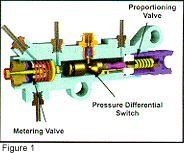 For
these reasons and others, most technicians do not take the time to understand what role each of these valves plays in the operation of the brake system. Not having an understanding of this prevents the technician from knowing when to add these valves to the list of possible causes when diagnosing a specific brake problem. These valves can and do fail depending on the valve's design and location on the vehicle. For
these reasons and others, most technicians do not take the time to understand what role each of these valves plays in the operation of the brake system. Not having an understanding of this prevents the technician from knowing when to add these valves to the list of possible causes when diagnosing a specific brake problem. These valves can and do fail depending on the valve's design and location on the vehicle.
There are three main types of brake valves in use on today's brake systems: metering valves, proportioning valves and pressure difference switches. Although not actually a valve, the pressure differential switch is usually grouped together with brake valves when discussing brake system operation. Before we proceed, we have to get some terminology straight. The valve pictured in Figure 1 is not a proportioning valve. The entire valve assembly is called a combination valve. Modern vehicles house more than one valve in a common housing to save on production costs.
 Proportioning Valve Proportioning Valve
The proportioning valve is designed to prevent rear wheel lockup during panic braking. It is needed for two main reasons - most vehicles use drum brakes in the rear and all vehicles experience weight transfer during a panic stop. Rear drum brakes are hydraulic over mechanical in design. If too much pressure is supplied to the wheel cylinders, lockup will occur. All vehicles, those with both rear drum and rear disc brakes, will experience weight transfer during a panic stop. When weight is taken off the rear wheels during a panic stop the tendency for the rear brakes to lockup will increase. The proportioning valve is designed to limit the pressure to the rear brakes during a panic braking situation.
The most important point to understand about proportioning valves is when they work - only during panic braking. This means that a vehicle could potentially go its whole life without ever using its proportioning valve. Think about the little old lady that drives to and from church and the grocery store. It is possible that she will never have the need to make a panic stop and therefore never activate her proportioning valve. The other half of that equation is all those who drive near her will probably get a chance to see if their proportioning valves work!
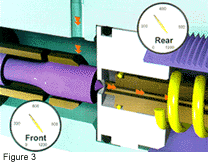 Hydraulic Proportioning Valves Hydraulic Proportioning Valves
Most vehicles incorporate a proportioning valve that uses the pressure in the brake system to know when a panic braking situation is taking place. A typical proportioning valve is pictured in Figure 2 on. The main components of the valve include the piston, spring, fluid restrictor and valve housing. During normal braking the fluid flow is unrestricted through the proportioning valve, as in Figure 3.
This is where the proportioning valve spends most of its life. The spring prevents the piston from moving until a certain pressure is reached. This pressure is known as the knee point. When the vehicle experiences a panic braking situation the system pressure will increase dramatically. When the pressure reaches the knee point it is strong enough to compress the spring. As the piston moves, its opening presses against the fluid restrictor, as shown in Figure 4. This starts to limit the pressure to the rear brakes.
 If
the panic braking situation continues and system pressure increases past the knee point the piston will be pushed tightly against the fluid restrictor which shuts off any more pressure from reaching the rear brakes (see Figure 5). The knee point and maximum pressure allowed to the rear brakes vary with each vehicle and the numbers shown in the previous figures are for reference only. When the brakes are released, the spring pushes the piston back to its rest position, which opens the fluid passage to the rear brakes. There are other designs of hydraulic proportioning valves. They operate different internally, but accomplish the same outcome - prevent rear lockup during panic braking. Also realize RWD vehicles use one proportioning valve while FWD vehicles use two. On a FWD, each rear brake is on a separate circuit so two valves are needed. If
the panic braking situation continues and system pressure increases past the knee point the piston will be pushed tightly against the fluid restrictor which shuts off any more pressure from reaching the rear brakes (see Figure 5). The knee point and maximum pressure allowed to the rear brakes vary with each vehicle and the numbers shown in the previous figures are for reference only. When the brakes are released, the spring pushes the piston back to its rest position, which opens the fluid passage to the rear brakes. There are other designs of hydraulic proportioning valves. They operate different internally, but accomplish the same outcome - prevent rear lockup during panic braking. Also realize RWD vehicles use one proportioning valve while FWD vehicles use two. On a FWD, each rear brake is on a separate circuit so two valves are needed.
 Hydraulic-activated
proportioning valves have some disadvantages. Since their only input is the system pressure, they have no way of knowing if the vehicle's load changes. Ideally, if the rear of the vehicle is loaded, the rear brakes should be allowed to do more of the work. The other disadvantage of older hydraulic-activated proportioning valves relates to when there is a front hydraulic failure. If there is no front pressure, the rear brakes must do all of the stopping and excessive pedal pressure will be needed. Guess what the proportioning valve "thinks" is happening? You got it - panic braking. It will do the job it is supposed to, which is to limit the rear brake pressure at a time when you really need it. Hydraulic-activated
proportioning valves have some disadvantages. Since their only input is the system pressure, they have no way of knowing if the vehicle's load changes. Ideally, if the rear of the vehicle is loaded, the rear brakes should be allowed to do more of the work. The other disadvantage of older hydraulic-activated proportioning valves relates to when there is a front hydraulic failure. If there is no front pressure, the rear brakes must do all of the stopping and excessive pedal pressure will be needed. Guess what the proportioning valve "thinks" is happening? You got it - panic braking. It will do the job it is supposed to, which is to limit the rear brake pressure at a time when you really need it.
Diagnosing Hydraulic Proportioning Valves
 Whether
or not you take the additional steps to inspect or diagnose a vehicle's hydraulic proportioning valve will depend on the following: Whether
or not you take the additional steps to inspect or diagnose a vehicle's hydraulic proportioning valve will depend on the following:
- Could the customer's compliant involve the proportioning valve?;
- What is the condition and location of the combination valve?; and
- What type of proportioning valve does the vehicle have?
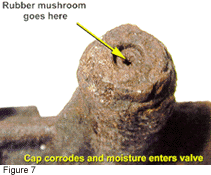 The
proportioning valve will only be added to our list of possible causes if the customer's complaint involves rear-wheel lockup under panic braking. We must ask the customer when the rear wheel lockup is occurring - light to normal or heavy to panic braking? If the answer is panic braking, the valve is on our list, but it won't be the only thing on our list (see April's article on rear-wheel lockup for more information). The valve's design will determine how and when we are going to diagnose it. The
proportioning valve will only be added to our list of possible causes if the customer's complaint involves rear-wheel lockup under panic braking. We must ask the customer when the rear wheel lockup is occurring - light to normal or heavy to panic braking? If the answer is panic braking, the valve is on our list, but it won't be the only thing on our list (see April's article on rear-wheel lockup for more information). The valve's design will determine how and when we are going to diagnose it.
The design of some proportioning valves allows two things - more chance for failure and an easy way to diagnose them. If we take a look at the proportioning valve in Figure 6 we will see the cap screw that holds the piston and spring in place is vented. In the vent hole is a small rubber "mushroom" that is supposed to prevent any moisture from entering the cap screw. If this style of valve is mounted low on the vehicle, as in most rear-wheel-drive vehicles, it can be exposed to a high degree of moisture. This is especially true where road salts are used for snow and ice removal. The moisture can corrode the cap screw and allow water to enter into the area where the piston travels in the cap screw (see Figure 7). This causes the inside of the cap screw to corrode which bonds the piston and cap screw together (see Figure 8.). Normally when the cap screw is removed, the cap screw, spring and piston are separate pieces. This corrosion prevents the piston from moving when a panic braking situation occurs.
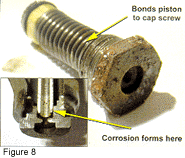 The
same thing that allows the valve to fail is what will allow us to check it - the cap screw vent hole. First determine if the valve is a good candidate by its external appearance. If the outside of the valve and especially the cap screw are corroded then it is a good candidate. Remove the rubber mushroom from the cap screw. Next insert a paperclip so that it bottoms out in the piston as in Figure 9. Have an assistant start the vehicle and apply heavy pedal pressure to simulate a panic braking situation. The paperclip should push against you and travel about 1/32" to 1/16" as the piston moves. If the paperclip doesn't move the piston is seized in the cap screw and the valve will have to be replaced. This test will work on any proportioning valve that is vented through the cap screw and should be part of your normal inspection if the valve's exterior condition merits it. The
same thing that allows the valve to fail is what will allow us to check it - the cap screw vent hole. First determine if the valve is a good candidate by its external appearance. If the outside of the valve and especially the cap screw are corroded then it is a good candidate. Remove the rubber mushroom from the cap screw. Next insert a paperclip so that it bottoms out in the piston as in Figure 9. Have an assistant start the vehicle and apply heavy pedal pressure to simulate a panic braking situation. The paperclip should push against you and travel about 1/32" to 1/16" as the piston moves. If the paperclip doesn't move the piston is seized in the cap screw and the valve will have to be replaced. This test will work on any proportioning valve that is vented through the cap screw and should be part of your normal inspection if the valve's exterior condition merits it.
Most proportioning valves are not vented through the cap screw. There is not a quick check for these types of valves. These valves should only be checked if the customer's complaint indicates a possible proportioning valve problem. Most shops do not have pressure gauges so the process used to diagnose the problem will have to be a process of elimination. All other possible causes will have to be checked before the proportioning valve is condemned.
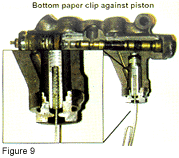 Pressure
gauges are the best way to diagnose a failed proportioning valve. A gauge is installed into the front and rear hydraulic circuits. The vehicle is started and the brake pedal is applied with heavy pedal pressure to duplicate a panic braking situation. The front and rear pressures should be different. Most manufacturers do not publish these pressures. The rear brakes usually are "shut" down between 500 and 800 psi while the fronts can climb to well over 1,200 psi. What you are looking for is whether the rear pressure has been limited. If the pressures are equal then the valve is not working and will have to be replaced to correct the problem. Pressure
gauges are the best way to diagnose a failed proportioning valve. A gauge is installed into the front and rear hydraulic circuits. The vehicle is started and the brake pedal is applied with heavy pedal pressure to duplicate a panic braking situation. The front and rear pressures should be different. Most manufacturers do not publish these pressures. The rear brakes usually are "shut" down between 500 and 800 psi while the fronts can climb to well over 1,200 psi. What you are looking for is whether the rear pressure has been limited. If the pressures are equal then the valve is not working and will have to be replaced to correct the problem.
 Mechanical Proportioning Valves Mechanical Proportioning Valves
Some vehicles use ride height to sense what should be done with the rear brakes. If a vehicle is in a panic brake situation, weight is transferred to the front and rear ride height changes. Likewise, if the rear of the vehicle is loaded then the rear ride height changes. Engineers came up with "smart" proportioning valves that use ride height to determine what to do with the rear brake pressure. These valves have several different names depending on who is talking about them. They can be referred to as "load sensing proportioning valves," "height sensitive control valves" or "smart proportioning valves." Instead of using hydraulic pressure they use a mechanical linkage to the vehicle's rear suspension as shown in Figure 10. There are many different variations of this type of valve, but all do the same job.
 There
are three main positions for these types of valves. The position it spends most of its life is where the vehicle is operating at normal ride height and performing routine stops (see Figure 11). In this position the rear brakes are allowed to do their fair share of the vehicle's braking. There
are three main positions for these types of valves. The position it spends most of its life is where the vehicle is operating at normal ride height and performing routine stops (see Figure 11). In this position the rear brakes are allowed to do their fair share of the vehicle's braking.
The next most common position for the valve is when the vehicle is carrying a load. When the vehicle is loaded the valve is opened further (Figure 12) to allow the rear brakes to do more braking. This is one area that sets it apart from its hydraulic counterpart.
The third possible position occurs during panic braking. If a panic braking situation occurs then weight transfer takes place and rear ride height increases (see Figure 13). When this takes place, the linkage to the valve restricts pressure to the rear brakes to prevent rear-wheel lockup.
 One
of the most important points to understand about these valves is because they rely on ride height to work, their adjustment will need to be checked periodically. As a vehicle ages, its ride height can change. This will affect the smart valve's operation. If the vehicle's ride height is lower than it should be and the valve's adjustment is not changed to compensate for this it will allow the rear brakes to work longer than they are supposed to. The valve "thinks" the vehicle is in a constant loaded condition. One
of the most important points to understand about these valves is because they rely on ride height to work, their adjustment will need to be checked periodically. As a vehicle ages, its ride height can change. This will affect the smart valve's operation. If the vehicle's ride height is lower than it should be and the valve's adjustment is not changed to compensate for this it will allow the rear brakes to work longer than they are supposed to. The valve "thinks" the vehicle is in a constant loaded condition.
Another related point is that nothing can be done to alter ride height without affecting the valve's operation. The addition of helper springs, air bags or even high pressure gas shocks can be enough to change the valve's operation. Anything that increases rear ride height will cause the valve to "think" a panic braking situation is taking place. It will restrict fluid pressure to the rear brakes and cause the fronts to do more work. The addition of these items can also change how soon weight transfer takes place.
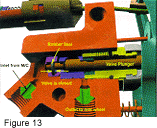 There
are many vehicles equipped with some variation of smart valve. Plymouth and Dodge Mini-vans, Taurus and Sable sedans, Volkswagen and Audis, Windstar vans, Toyota Pickup and 4-Runner, and many of the 1/2- and 1-ton domestic pickups all have load sensing proportioning valves of some sort. Keep in mind that all FWD vehicles use a valve that actually houses two valves, not one. These vehicles are diagonally split and need one valve for each rear wheel. There
are many vehicles equipped with some variation of smart valve. Plymouth and Dodge Mini-vans, Taurus and Sable sedans, Volkswagen and Audis, Windstar vans, Toyota Pickup and 4-Runner, and many of the 1/2- and 1-ton domestic pickups all have load sensing proportioning valves of some sort. Keep in mind that all FWD vehicles use a valve that actually houses two valves, not one. These vehicles are diagonally split and need one valve for each rear wheel.
Adjusting & Diagnosing Mechanical Proportioning Valves
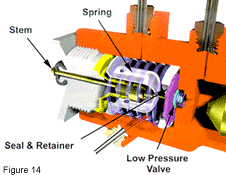 The adjustment of these valves should be checked periodically. This is especially true if anything is done to alter the vehicle's ride height. The steps involved in adjusting these valves vary greatly from one manufacturer to another. Generally the domestic procedures are fairly simple when compared to either the European or Japanese. Domestic adjustment procedures usually do not involve the use of pressure gauges, while both the European and Japanese require them. It is not possible to cover these procedures in this article, so when valve adjustment is necessary consult the appropriate service manual. The adjustment of these valves should be checked periodically. This is especially true if anything is done to alter the vehicle's ride height. The steps involved in adjusting these valves vary greatly from one manufacturer to another. Generally the domestic procedures are fairly simple when compared to either the European or Japanese. Domestic adjustment procedures usually do not involve the use of pressure gauges, while both the European and Japanese require them. It is not possible to cover these procedures in this article, so when valve adjustment is necessary consult the appropriate service manual.
Diagnosing the operation of these valves holds similar challenges. Depending on the type of hydraulic system valve failure can come in different forms. If the vehicle has a front to rear split system (RWD) then the valve can fail in two typical ways - open or closed. If the valve fails open or stays open too long it will cause rear brake problems. If the valve fails closed or stays closed too long it will cause front brake problems. On the other hand, if the vehicle is a FWD with a diagonal split hydraulic system then the possible combinations increase. Since there are two valves, it results in eight possible failure combinations.
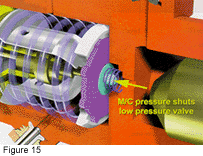 The
best method to check valve function is by using a set of pressure gauges. If pressure gauges are not available, a primitive check can be made. If you understand how these valves work then you can perform a basic function check by checking fluid flow at different ride heights. The steps required for a RWD are slightly different than those for a FWD. The reason is the FWD valve has two valves so each rear wheel must be checked separately. To check a FWD vehicle, start with the tires on the ground, open the right rear bleeder and have an assistant slowly push the brake pedal half of the way down. Note the size and strength of the fluid flow. Close the bleeder and do the same with the left rear. Make sure your assistant is consistent with the pedal force. The size and strength of the streams should be close to equal. With the tires on the ground the valve should be open and fluid flow should be uninterrupted. If one of the streams is considerably less than the other chances are the valve is stuck closed. Next raise the vehicle by the frame and let the rear wheels hang. This simulates a panic braking situation and should restrict the valves. Repeat the previous steps and note whether there is a difference from side to side and from when the tires were on the ground. Theoretically, the streams should be reduced with the wheels hanging if the valves are working. If both sides are doing the same thing, both open when they should be closed or both closed when they should be open, try adjusting the valve first. If adjusting the valve doesn't correct the problem then replacement is in order. If there is a side-to-side difference, it is internal and the valve should be replaced. The
best method to check valve function is by using a set of pressure gauges. If pressure gauges are not available, a primitive check can be made. If you understand how these valves work then you can perform a basic function check by checking fluid flow at different ride heights. The steps required for a RWD are slightly different than those for a FWD. The reason is the FWD valve has two valves so each rear wheel must be checked separately. To check a FWD vehicle, start with the tires on the ground, open the right rear bleeder and have an assistant slowly push the brake pedal half of the way down. Note the size and strength of the fluid flow. Close the bleeder and do the same with the left rear. Make sure your assistant is consistent with the pedal force. The size and strength of the streams should be close to equal. With the tires on the ground the valve should be open and fluid flow should be uninterrupted. If one of the streams is considerably less than the other chances are the valve is stuck closed. Next raise the vehicle by the frame and let the rear wheels hang. This simulates a panic braking situation and should restrict the valves. Repeat the previous steps and note whether there is a difference from side to side and from when the tires were on the ground. Theoretically, the streams should be reduced with the wheels hanging if the valves are working. If both sides are doing the same thing, both open when they should be closed or both closed when they should be open, try adjusting the valve first. If adjusting the valve doesn't correct the problem then replacement is in order. If there is a side-to-side difference, it is internal and the valve should be replaced.
Metering Valve
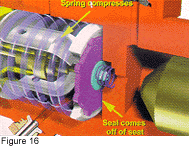 The
metering valve is a balance or timing valve. It is used on most RWD vehicles that have disc brakes on the front and drum brakes on the rear. Disc and drum brakes apply at different times. Disc brakes will apply immediately while drum brakes take a while to apply. The reason for this is the return springs in the drum brakes prevent the drum brakes from working until a certain pressure is reached. Disc brakes have no return springs so they apply instantly. The metering valve's job is to "hold" the front brakes off until the rear brakes start to apply. For this reason it is also known as a "hold off" valve. If no metering valve were used the vehicle would nose dive and premature wear could occur in the front brakes. The
metering valve is a balance or timing valve. It is used on most RWD vehicles that have disc brakes on the front and drum brakes on the rear. Disc and drum brakes apply at different times. Disc brakes will apply immediately while drum brakes take a while to apply. The reason for this is the return springs in the drum brakes prevent the drum brakes from working until a certain pressure is reached. Disc brakes have no return springs so they apply instantly. The metering valve's job is to "hold" the front brakes off until the rear brakes start to apply. For this reason it is also known as a "hold off" valve. If no metering valve were used the vehicle would nose dive and premature wear could occur in the front brakes.
The metering valve consists of the following main components - stem, diaphragm, spring, seal and retainer and low pressure valve (Figure 14). Metering valve operation takes place in three stages. When the brakes are first applied the low pressure valve closes off the passage to the front brakes (see Figure 15). Once the pressure in the system is high enough to overcome the return springs in the rear drum brakes it also is high enough to just open the metering valve (see Figure 16). This is known as the blend pressure. Once the metering valve starts to open and pressure is allowed against the diaphragm, the difference in pressure on each side of the diaphragm causes the valve to fully open (see Figure 17). At this point both the disc and drum brakes will apply at the same time and balanced braking will be achieved. Unlike the proportioning valve, the metering valve works every time the brake is applied.
The majority of RWD vehicles use metering valves. They are usually part of the combination valve. FWD vehicles do not use metering valves. A FWD vehicle does about 80 percent of its braking with the front axle. There is no need to "hold" them off.
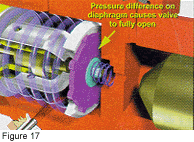 Diagnosing Metering Valves Diagnosing Metering Valves
The diagnosis of a metering valve is quite simple. All metering valves use a stem. Depending on the design of the valve, the stem will either protrude through or be underneath a rubber dust cap. To check the operation of the metering valve simply observe the stem during the brake apply and release cycle. It should move out when the brake is applied and return to its rest position once the brake is released. Most metering valve failures are caused by external not internal problems. The rubber cap that keeps moisture out eventually dry rots and/or the cap screw corrodes. Either one of these will allow moisture to enter around the stem. The area between the stem and cap screw corrodes, which eventually bonds the two together (see Figure 18).
The metering valve can fail in one of two common positions. It can fail where it is stuck in an open position. This would be the same as not having a metering valve on the vehicle. The vehicle may experience a nose dive condition, and if the valve has been stuck open long enough there may be some premature front pad wear.
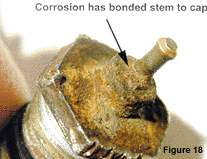 The
metering valve can also stick in a position where it cannot open all of the way. This would be similar to having a faucet between the front brakes and the master that is only part way open. This usually causes a lack of stopping power because the front brakes are not working at 100 percent. If the metering valve stem fails to move when the brake is applied and released it needs to be replaced regardless of the vehicle's symptoms. The
metering valve can also stick in a position where it cannot open all of the way. This would be similar to having a faucet between the front brakes and the master that is only part way open. This usually causes a lack of stopping power because the front brakes are not working at 100 percent. If the metering valve stem fails to move when the brake is applied and released it needs to be replaced regardless of the vehicle's symptoms.
The metering valves with the highest failure rate are those that are mounted low on the vehicle. These valves are exposed to the elements just like the low mounted proportioning valves. The failure rate for these valves is much higher than what people think. In the snow belt areas it can be as high as 20 to 30 percent.
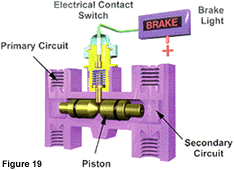 Pressure Differential Switch Pressure Differential Switch
All modern vehicles are equipped with a red brake warning light. One of the purposes of this light is to inform the driver of either a fluid loss or pressure loss condition. Fluid level switches are used for fluid loss and pressure differential switches are used for sensing pressure. Pressure differential switches use a piston that is exposed to both the primary and secondary hydraulic circuits as in Figure 19. The pressure differential switch consists of the piston, electrical contact switch, wiring and warning light.
If the vehicle experiences a hydraulic leak or failure of either the primary or secondary half of the master cylinder, a difference in circuit pressure will be created. The pressure from the functioning portion of the hydraulic system will force the pressure differential piston toward the side with the pressure loss. The movement of the piston will cause the electrical contact switch to go from open to closed as in Figure 20. This will complete the ground circuit to the red warning light and will illuminate it.
 The
pressure differential switch piston never moves until a pressure difference occurs. The bore in which it travels becomes corroded and tarnished over time. When the piston does move, it does not always want to return after the necessary repairs are made. The most effective method to re-center the piston is to repair the failure, bleed the system and then create a pressure loss opposite what moved the piston in the first place. If the original failure was a broken rear brake line, fix the line and bleed the rear brakes. Next open a front bleeder and spike the brake pedal a couple of times taking care not to exceed half pedal travel. Tapping on the side of the valve with a rubber or brass hammer can also aid in the process. If after using this method the piston still won't re-center, then the combination valve should be changed. The
pressure differential switch piston never moves until a pressure difference occurs. The bore in which it travels becomes corroded and tarnished over time. When the piston does move, it does not always want to return after the necessary repairs are made. The most effective method to re-center the piston is to repair the failure, bleed the system and then create a pressure loss opposite what moved the piston in the first place. If the original failure was a broken rear brake line, fix the line and bleed the rear brakes. Next open a front bleeder and spike the brake pedal a couple of times taking care not to exceed half pedal travel. Tapping on the side of the valve with a rubber or brass hammer can also aid in the process. If after using this method the piston still won't re-center, then the combination valve should be changed.
Special Purpose Pressure Differential Switch
 There
are a number of pressure differential switches that perform a second function. In addition to completing the ground to the red warning light, they also shut off the fluid flow to the rear brakes if a rear hydraulic failure has occurred. The fluid flow to the rear brakes is through the ports in Figure 21. If a rear pressure loss occurs then the pressure differential piston moves toward the rear brake circuit and closes off the fluid passages to the rear brakes as in Figure 22. When dealing with this type of valve you must re-center the valve before the rear brakes can be bled. Bleed the lines at the master cylinder and the fitting on the valve. Open a front bleeder and spike the brake pedal a couple of times taking care not to exceed half pedal travel. This usually will re-center the piston. If it won't re-center, the combination valve will have to be replaced. There
are a number of pressure differential switches that perform a second function. In addition to completing the ground to the red warning light, they also shut off the fluid flow to the rear brakes if a rear hydraulic failure has occurred. The fluid flow to the rear brakes is through the ports in Figure 21. If a rear pressure loss occurs then the pressure differential piston moves toward the rear brake circuit and closes off the fluid passages to the rear brakes as in Figure 22. When dealing with this type of valve you must re-center the valve before the rear brakes can be bled. Bleed the lines at the master cylinder and the fitting on the valve. Open a front bleeder and spike the brake pedal a couple of times taking care not to exceed half pedal travel. This usually will re-center the piston. If it won't re-center, the combination valve will have to be replaced.
 In
closing, there are many variations of brake valving in use on today's vehicles. These valves do not last forever and need to be taken into account during both the inspection and diagnosis stages of brake service. Having a clear understanding of which valves perform which functions will aid you in determining when they should be on your list of components to check during the diagnosis. Once you start checking them, especially the high failure rate type, you will find that many are in need of replacement and if not serviced will affect proper system operation. In
closing, there are many variations of brake valving in use on today's vehicles. These valves do not last forever and need to be taken into account during both the inspection and diagnosis stages of brake service. Having a clear understanding of which valves perform which functions will aid you in determining when they should be on your list of components to check during the diagnosis. Once you start checking them, especially the high failure rate type, you will find that many are in need of replacement and if not serviced will affect proper system operation.
 Return to the Tip List. Return to the Tip List.
-- Disclaimer --Information
on this Web Site is provided by members of the "Aero Cruiser Classics" Motor home Club. All
information on this site is contributed by the club members or outside sources and is believed to be reliable; however,
there is no warranty or guarantee that said information or advice is correct or free of defect. It is
offered on a best effort basis and is to be used at your own risk.
| 
